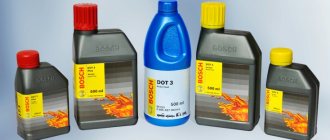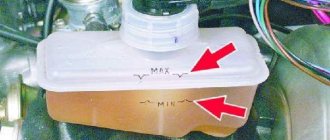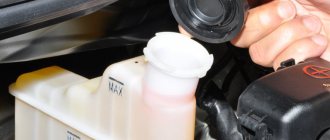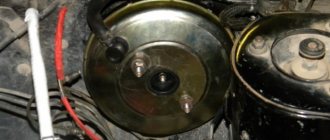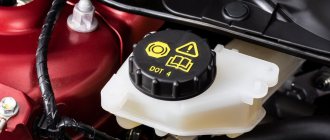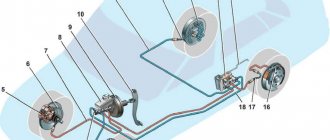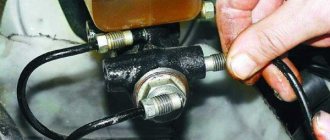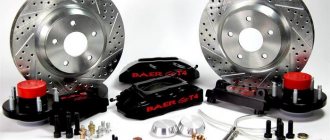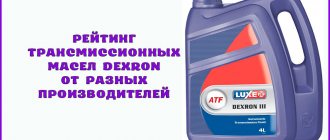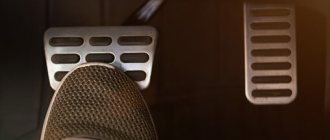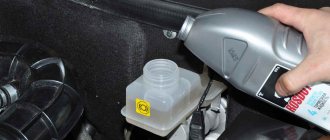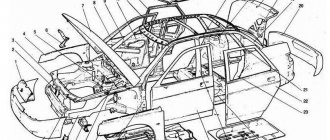Brake fluid has very serious standards requirements, since accurate operation of the brakes, first of all, depends on the condition of the fluid in the brake system, and not just on the brake pads. During operation, its properties deteriorate, so the fuel fluid requires periodic replacement.
Brake fluids are usually classified in accordance with the standards of the US Department of Transportation (Department of Transportation), which, in the abbreviated abbreviation, will sound like DOT. The classification indicators of TF are boiling point and viscosity. Brake fluid classes received their own markings from the department that produced them, as a result of which generally accepted classes arose: DOT-3, DOT-4, DOT-5 and DOT-5.1. DOT 4 is the most commonly used in the braking system of various cars, which is why we want to pay such attention to DOT 4 brake fluid by writing an entire article.
Technical characteristics of DOT 4
The main composition of all brake fluids, except DOT 5 (using silicone), is polyethylene glycols and polyesters of boric acid. The main physical and chemical characteristics of DOT 4 and others that determine quality:
- viscosity;
- boiling temperature;
- anti-corrosion;
- hygroscopicity.
Minimum boiling point of brake fluid
Viscosity graph of TFA DOT-3, DOT-4, DOT-5 and DOT-5.1 depending on temperature
The main standards in the characteristics of DOT-4 brake fluid for manufacturers are ISO (DIN) 4925 standards, SAE J-1703, FMVSS and PN-C-40005 requirements.
Density at an ambient temperature of +20°C and an atmospheric pressure of 765 mm Hg according to standards is 1.03 - 1.07 g/cm³.
The viscosity of DOT-4 fluid fluid should be more than 750 mm2/s, but not more than 1800. It is responsible for the quality of brake performance. The lower the viscosity, the faster the braking force is transmitted.
According to standards, the boiling point of DOT 4 brake fluid is not lower than 250 °C (if new without moisture) and not lower than 165 degrees with the amount of moisture up to 3.5% (old, so-called wet fluid).
Anti-corrosion is associated with acidity, which should be pH 7.0 – pH 11.5. Protective properties against corrosion are provided by additional special additives.
The hygroscopicity by borates, which are used in the composition of the brake fluid; they are able to bind water molecules that come from the air during operation, but still, over time, moisture accumulates, because glycol brake fluids are hygroscopic.
DOT 4 classification
Some manufacturers, in accordance with the standard, may slightly change the characteristics of the DOT-4 brake fluid within certain limits. And since even minor differences in density or viscosity will affect performance, a certain classification has arisen.
- DOT 4 class 6;
- DOT 4 ESP;
- DOT 4 Super;
- DOT 4 HP;
- DOT 4.5;
- DOT 4+.
Brake fluid DOT 4 class 6 , in contrast to the base composition, has improved low-temperature characteristics - kinematic viscosity at -40°C in the region of 700 mm²/s (compared to the base 1800 mm²/s).
DOT 4 ESP is designed for modern cars. But don’t think that this is a completely different product; DOT 4 ESP has only one difference from DOT 4 - it is recommended to be poured into a car with an ESP system.
DOT 4 Super is designed for vehicles that do not have ABS and ESP systems installed. It resists the formation of steam bubbles better than the usual composition.
DOT 4 HP is used on cars with ASR, ABS and ESP systems. It has a lower viscosity, therefore, in electronic control systems, pressure can change faster.
Also in the classification, domestically produced products marked DOT 4.5 and DOT 4+ . True, such liquids are not related to the generally accepted American system.
Classification
The brake fluid standard for most countries in the world is the same - DOT. It was developed by the US Department of Transportation. This standard indicates that the brake fluid complies with FMVSS No. 116, which allows use in the brake systems of passenger cars and commercial vehicles, adjusted for their technical characteristics.
In addition to the American standard, brake fluids are marked in accordance with ISO, SAE, etc. standards adopted in Europe and Asia.
But all these standards classify TF according to two main parameters: kinematic viscosity and boiling point. The first shows the operating temperature range, and the second is responsible for preventing the occurrence of the so-called “vapor lock”, which occurs at high temperatures, which can lead to the brake pedal not working at the right time.
Based on the boiling point, there are two states of brake fluid: dry, that is, without water, and moistened, containing up to 3.5% water. The first is determined only on fresh liquid, which still has high performance properties. The moistened boiling point refers to a fuel oil that has already been in use for about 2-3 years.
Differences between DOT-4 brake fluid and DOT 3, DOT 5 and DOT 5.1
As we have already figured out, in brake fluids DOT 3, DOT 4 and DOT 5.1 the chemical base is the same , but still, the boiling point and moisture absorption due to additional additives and borates are different , so the properties, as well as their applicability, differ.
Main classification indicators of brake fluid
DOT 3 - based on compounds of 2-atomic alcohols of glycols. That is why it is very hygroscopic, and also very aggressive to paint and rubber brake pads, which is unacceptable in the brake systems of modern cars. So they try not to use DOT 3, and if they do, it’s only in old cars with drum or disc brakes (only on the front wheels), because its price is low and, for an economy option, it does its job well for a year and a half.
Since liquid of class DOT 3 quickly absorbs moisture, after opening the container with liquid it should not be used for a week, and try not to unscrew the cap of the expansion tank in the car unnecessarily (unless topping up is needed).
DOT 5.1 is even more modern than DOT 4, it has the highest boiling point, and the viscosity is the lowest, but there is one big BUT - it, like DOT 3, is quickly saturated with moisture (service life is no more than a year). Such characteristics allow it to be successfully used in the braking system of racing cars. In the DOT-5 class there is one subtype, specially designed for cars with an anti-lock braking system; such liquids have a mixed structure (glycols and silicone).
What you need to know about brake fluid?
DOT 5 is as close as possible to ideal parameters, since, due to the fact that it is based on silicones, it has both a high boiling point and low viscosity, has good lubricating properties, is neutral towards rubber and metals, and absorbs moisture from the environment very quickly. slowly. Such properties allow you to replace DOT class fluid 5 times every 5 years.
But not everything is as good as it might seem - with such excellent technical characteristics, DOT 5 liquid also has its drawbacks. This minus determines the difference between DOT 4 and DOT 5 - the second is not intended for use in cars with ABS systems. First, because silicone repels water and does not mix with the liquid, it can freeze at low temperatures. Secondly, it has a high degree of aeration (saturated with air).
The table below contains data that shows how DOT 3 differs from DOT 4, as well as the difference from DOT 5.
| Liquid class | Boiling point (dry), °C | Viscosity (at -40°C, mm²/s | Density (at +20°C), g/cm³ | Ph |
| DOT 3 | 243 | 1270 | 1,031 | 8,81 |
| DOT 4 | 250 | 750-1800 | 1,03-1,07 | 8,2 |
| DOT 5 | 260 | 900 | 0,96 | 7-11,5 |
Based on all the characteristics of other brake fluids, we see that DOT 4 fluid has the most optimal performance, which is why it is so popular and most used in standard-use vehicles.
Brake fluid color coding
Do brake fluids differ in color?
The FMVSS No. 116 DOT standard, as well as others developed later (SAE J 1703 and ISO 4925), require color coding of brake fluid according to the specific base, in order to exclude the possibility of mixing categorically incompatible fluids. But such a difference will not make it possible to determine what you have filled: DOT 3, DOT 4 or DOT 5.1, because such liquids will often have one color - amber-yellow, but silicone liquid of the DOT 5 class is usually painted pink.
In addition to the color, the bottle must contain the inscription “SILICONE BASE” (SBBF) for DOT-5 and “NON-SILICONE BASE” (NSBBF) on a bottle with liquid class DOT-5.1.
The picture below shows the color options of different classes.
Brake fluid shades DOT 3, DOT 4, DOT 5 and DOT 5.1
As we see, DOT 4 compositions can have the most shades. In color, the difference between DOT 3 and DOT 4 is almost imperceptible, since they are all characterized by shades of yellow. But DOT 5 has a more pronounced red color (shades may vary depending on the manufacturer). DOT 5.1 for most brands is presented as almost transparent (slightly with a yellow tint).
Other standards
ISO 4925
ISO - International Organization for Standardization (international organization for standardization).
JIS K2233
JIS - Japanese Industrial Standards.
SAE J 1703/1704
SAE - Society of Automotive Engineers (society of automotive engineers).
Brake fluid compatibility
The question: “is it possible to mix brake fluids” should be answered as follows - there are no critical contraindications! It is permissible to mix DOT groups, which contain glycols and polyesters. That is, liquids of class DOT 3, DOT 4 and 5.1 can be mixed , although this is not recommended. Therefore, the question is rather not so much whether Dot 3 and Dot 4 are compatible, but rather what the consequences of mixing will be. As a rule, only topping up is allowed, and then you must adhere to the mixing rule .
Brake fluid with a higher DOT class can be added to a lower one, but the reverse addition is prohibited.
Brake fluids are not compatible only if you try to mix silicone DOT 5 with glycol fluids, or ABS designed to work with any other. So, when the need for mixing arises, read all the labels carefully; the labeling of such TJs is indicated separately.
If the choice is whether it is possible to mix DOT 5.1 and DOT 5.1/ABS , then the answer is definitely not !
General information about TZ and how to choose the right one
This categorical ban on the compatibility of brake fluids is due to the fact that they contain a different chemical composition of additives and their stability in the “mix” may be violated.
From the above we can conclude that:
- in DOT 3 you can add DOT 4 or DOT 5.1;
- you can also add 5.1 to DOT 4;
- in a class 5.1 fuel tank you cannot add DOT 3 or 4.
It is strictly forbidden to mix DOT 4, DOT 3 and DOT 5.1 with DOT 5 silicone liquid
Mixing liquids with glycol and silicone bases causes a chemical reaction, the result of which does not meet the requirements and standards for liquid liquids. If you switch from one class of fluid to another, thoroughly flush the brake system of the new vehicle! Moreover, you should know that it DOT 5 silicone liquid with any glycol liquid . Since the car’s brake lines are not designed for an aggressive reaction, and the rubber seals will simply be destroyed.
Brake fluid life
The service life and shelf life of brake fluid are two different things, but in this case they are almost identical, since the brake fluid equally absorbs moisture from both an open bottle (stored in the garage) and from the expansion tank with fluid in the car. Therefore, even if you drive the car very little, you will still have to change it after two years.
Brake fluid DOT 4 is changed every 2 years; TZH DOT 3 in 1.5 years; DOT 5 fluid must be replaced every 5 years; DOT 5.1 is designed for one year of service, but in racing cars it can be changed more often.
Also, the service life of liquids largely depends on the region of residence, and in places with high air humidity, liquid liquid will lose its technical properties much faster.
It is worth remembering that in 1 year the liquid can absorb about 3% moisture, and if the water content exceeds 8%, this will lead to a decrease in the boiling point. Therefore, it is recommended to perform a mandatory check once every 12 months. And refer to the expiration date indicated on the back of the flask. It may indicate how many years from the date of manufacture the product can be used, or exactly the year and month when the period expires.
Options for indicating the expiration date on the flask
You can determine the timing of replacement of compounds using a special tester that establishes the density of brake fluid DOT 4 and other classes. It measures the percentage of water accumulated in a liquid.
The factor that determines when to change the brake fluid is the moisture level.
Graph of brake fluid condition depending on humidity value.
To ensure that the boiling point of the “raw” liquid does not fall below 155 - 180 °C, the moisture content should be no more than 3.5 percent, in order to avoid boiling of the fluid and the appearance of vapor locks, leading to brake failure under extreme loads on the braking system.
Also, unsuitability can be easily determined visually when the composition noticeably darkens over time and sediment forms in it .
Even though the fluid in the brake circuits does not circulate and is less in contact with the atmosphere than in the reservoir, where its condition is checked (humidity may differ and be lower), it must be replaced, since the fluid often gets very hot in the pipes near the brake calipers , and as a result loses its original properties.
Replacement
Replacing brake fluid in modern cars is a process that is best left to service specialists.
In old cars, garage craftsmen changed the brake fluid themselves; fortunately, the process was not particularly complicated, requiring a minimum of tools and one partner. Particularly advanced ones could carry out the entire operation alone. It was necessary to pump out the old fluid from the reservoir, remove the hoses from the brake cylinder fittings, drain the fluid, and fill the hoses with new fluid. After this, pump DOT 4 through the system, getting rid of excess air, tighten the fittings and add liquid to the tank. Everything looks simple, but you need to know that in modern cars, brake fluid, in addition to its main purpose, also affects the operation of the ABS, as well as the car’s stabilization systems.
Problems in any of the systems will not lead to anything good. Considering the low cost of changing fluid at a service center, it makes sense to go there. And it will take a little time, so it’s better to do without amateur activities.
Which DOT 4 brake fluid is better?
The best TZ should have:
- high boiling point (with a margin);
- good lubricating properties;
- decent low-temperature viscosity;
- excellent protection against corrosion of all parts of the brake system.
In terms of classes, you should always use the fluid that is specified in the car manufacturer’s recommendations. But regarding brands, it’s a little more complicated, because in order to understand which brake fluid is better to buy, you need to look at the characteristics of each of them, read reviews, and see comparative tests.
Which TJ is better to buy?
The car market does not skimp on the number of different companies offering to buy their own vehicle, both class DOT 4 and DOT 5.1 or others. So the car owner naturally has a logical question: “what is the best brake fluid?”
The top 7 most commonly used and unbiased brands of DOT 4 brake fluid look like this:
The first position is held by the European “ Castrol 157D5A ” 1 l - it has excellent indicators both in viscosity and boiling point, but it can be confusing with additional protection both from counterfeiting and from the influence of the external environment, since it does not have soldered foil on the neck of the bottle.
Second place is held by the American “ Hi-Gear HG7044 ” - technical characteristics are in accordance with the standards and the price will be slightly lower. Available in 473 ml containers.
Liqui Moly DOT 4 (1 l, article number 8834 ) can be placed in third position. This liquid has a high boiling point, has good anti-corrosion properties and is excellent for cars with ABS.
In fourth position can confidently be “ Mobil Brake Fluid DOT 4 ” (1 l - article 150904R ). European mineral brake fluid that boasts optimal viscosity and stability.
Next come domestic liquids, such as: Sintec Super DOT-4 (910 g), RosDot 4 Life Safety (910 g), Alaska DOT-4 (1 l). For comparison, here is a table of the main characteristics of each option.
| Place in the ranking | Name | Boiling point “dry” t/l, °C | Viscosity (at -40°C), mm²/s | price, rub. |
| 1 | Castrol DOT 4 | 250 | 1200 | 760 |
| 2 | Hi-Gear HG7044 | 270 | 1193 | 240 |
| 3 | Liqui Moly DOT 4 | 230 | 700 | |
| 4 | Mobil Brake Fluid DOT 4 | 265 | 1300 | 640 |
| 5 | Sintec Super DOT-4 | 270 | 1172 | 230 |
| 6 | RosDot 4 Life Safety | 255 | 1600 | 190 |
| 7 | Alaska DOT-4 | 230 | 1600 | 220 |
Before buying brake fluid, study all its approvals, markings and other information. Pay attention to the purpose and date of manufacture indicated on the packaging, because TJ has an expiration date . Brake fluid DOT 4 class 6 has the best performance indicators. To avoid buying a fake, always pay attention to the integrity of the packaging and additional protection methods .
Despite the rating of the most popular and best brake fluids, sometimes it is still better to give preference to a manufacturer whose bottle will be sealed with foil, because it makes it possible not only to further protect the fluid from moisture penetration, but also to protect against purchasing a low-quality product. Experienced car owners advise buying vehicles from well-known companies that are partners of large automakers.
British Petroleum
An excellent product from a well-known London company. The main feature of TJ is its high boiling point, due to which British Petroleum managed to gain great popularity among motorists. The brake system works perfectly even during heavy braking, since the fluid does not boil.
pros
- rich chemical composition;
- high boiling point;
- excellent viscosity indicator;
- low cost.
Minuses
- low anti-corrosion properties;
- short service life.
Answers to frequently asked questions
Where is DOT4 used?
The characteristics of DOT 4 brake fluid allow it to be used in hydraulic braking systems of predominantly disc type (front and rear). Also widely used in automobile clutch system.
What is the lifespan of DOT 4 brake fluid?
Without changing its characteristics, DOT 4 can last 2 years, after which the boiling point will decrease and the water content will increase, and after three years it can lead to loss of brakes.
Castrol Motorcycle Brake Fluid
Castrol Motorcycle Brake Fluid is a synthetic based brake fluid. The composition is designed for brake systems of 2- and 4-stroke motorcycles and scooters. The composition can be used in all climatic zones; it hardens only at -50 °C. Available in packages ranging from 0.25 to 1 liter.
The fluid's boiling point of 275°C exceeds DOT 4 requirements. The additives protect metal components and rubber seals in the system and prevent vapor lock from forming.
Pros:
- high boiling point;
- protects parts from corrosion and wear;
- Suitable for cars and motorcycles;
- low pour point.
Minuses:
- expensive (600 rubles for 500 ml).
Castrol Motorcycle Brake is designed primarily for sports motorcycles. Drivers usually don’t see the point in overpaying for a product to be poured into their cars.
